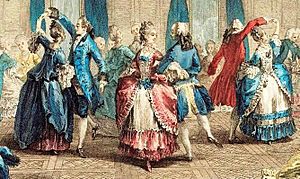Bourgeoisie facts for kids
The bourgeoisie (say: bur-zhwah-ZEE) is a word used to describe a group of people in society. These are often people who own businesses or factories. They are typically employers, meaning they hire other people to work for them. Their power and position in society come from their wealth, education, or the businesses they own. This is different from old noble families whose power came from their birth. For example, a person who owns a small cafe or a large factory would be considered part of the bourgeoisie.
In many countries, this term is similar to what we call the middle class. Unlike the proletariat (which means working-class people who do manual labor for money), the bourgeoisie usually doesn't do physical labor for their income. If they do work, it's often because they manage others. Their wealth often comes from the work of the many people they employ.
Contents
What is the Bourgeoisie?
The bourgeoisie is a social group that owns the "means of production." This means they own the tools, land, and factories needed to make goods or provide services. Because they own these things, they are often employers. They hire workers and manage businesses.
Their wealth and power come from their businesses and investments. This is different from the old aristocrats. Aristocrats got their power from their family name and land ownership. The bourgeoisie gained power through their hard work, education, and business success.
Where Did the Word "Bourgeoisie" Come From?
The word "bourgeoisie" comes from the French word bourgeois. This word was brought into the English language directly.
The French word bourgeois comes from an older French word, burgeis. This meant "an inhabitant of a town." Think of it like someone who lived in a city or a market town. The word burgeis itself came from bourg, which meant a market town or a medieval village. Even further back, bourg came from the Latin word burgus, meaning "fortress." So, originally, a "bourgeois" was someone who lived in a fortified town. These towns were often centers of trade and business.
Related Topics
Images for kids
-
Karl Marx, a famous thinker who wrote a lot about the bourgeoisie
-
Thomas Mann (1875–1955) wrote about the German upper bourgeoisie in his novel Buddenbrooks
See also
 In Spanish: Burguesía para niños
In Spanish: Burguesía para niños





